“New Dances: Edition 2016” showcases Juilliard Dance’s four classes of students in new choreography.
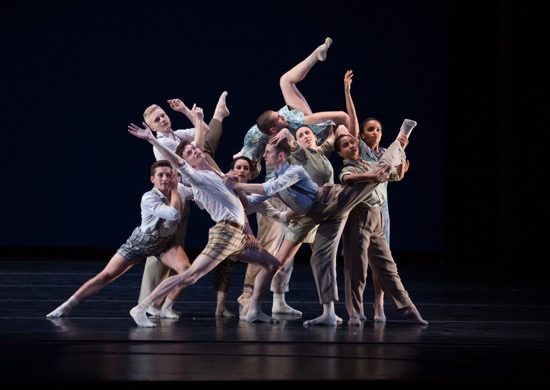
Members of Juilliard’s Class of 2017 assemble in Matthew Neenan’s Walk Me Through. Photo: Rosalie O’Connor
Every December, the Juilliard School presents its dance students in five public performances of works choreographed for them. Lawrence Rhodes, artistic director of the Juilliard Dance Division, commissions a piece for the members of each class in the school’s BFA program, from the freshmen through the seniors. These are densely populated works, with between twenty and two-dozen dancers apiece—a challenge for the four choreographers of New Dances: Edition 2016: John Heginbotham, Katarzyna Skarpetowska, Pam Tanowitz, and Matthew Neenan.
Since students audition to get into Juilliard’s BFA program, and the bar is set high, the performances in the Peter Jay Sharp Theater show how maturity and accumulated dance wisdom affect performing but don’t reveal a vast range of technical expertise. In other words, the first-year students, with only a few months at the school, are already accomplished (and endearingly zestful). Heginbotham, a Juilliard graduate himself, understands them very well.
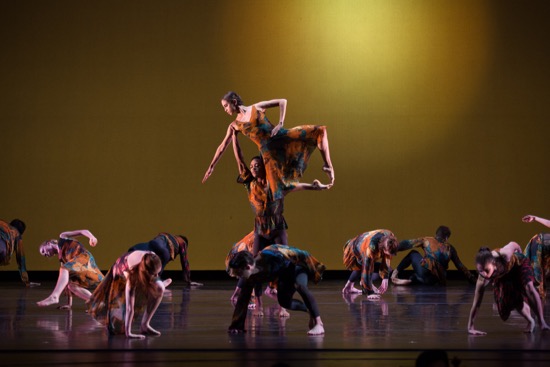
Juilliard Dance’s Class of 2020 in John Heginbotham’s First. Center: Javon Jones lifts Lúa Mayenco Cardenal. Photo: Roasalie O’Connor
Audiences for the performances receive a bonus. Three out of the four works are set to music that’s played live by various of Juilliard’s gifted music students. Heginbotham’s lively First is set to the first movement (Allegro ma non troppo) of Franz Schubert’s Quintet in C, D. 956, and even if Schubert considered the tempo to be not too speedy, the twenty-four dancers spring and sprint and bounce charmingly through it in whatever complex ways the chorographer comes up with. The steps have a fluent, playful air. The dancers, wearing mottled costumes in autumnal colors (Fritz Masten designed the costumes for all four works), may have brief fits of movement, some may be caught and lifted by others, and one may have a brief solo moment, before falling back into the crowd. However Heginbotham, wisely, doesn’t have them all onstage all the time. They appear in brief, brightly constructed trios: three men, one man and two women, one woman and two men. . . .A partners may carry on at the back of the stage while three people negotiate in front of them. One minute, dancers form two orderly competing squads; the next minute, the stage is a frenzy of arms and legs with individual agendas. Gender plays no fixed role when it comes to partnering.
There’s a point at which I find myself wishing for more quiet moments, but Heginbotham seems determined to keep pace with Schubert, and the dancers do not fail either of them.
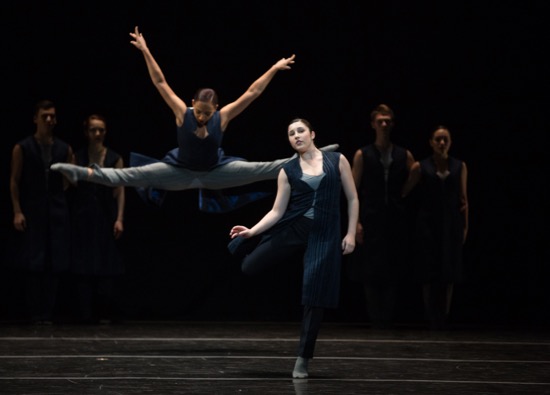
Juilliard Dance’s Class of 2019 in Katarzyna Skarpetowska’s The Saloneers. Foreground: Kylie James (L) and Maddie Hanson. Photo: Rosalie O’Connor
Skarpetowska (another Juilliard alum) also chose fast-paced music for her finely constructed The Saloneers: the Allegro Moderato from Frédéric Chopin’s Cello Sonata in G minor, op. 65 (splendidly played from a corner of the stage apron by cellist James Jeonghwan Kim and pianist Angie Zhang). In that G minor world, turbulence ripples up, as do poignant melodies. The twenty-four second year students in Skarpetowska’s cast inhabit it a touch more seriously than Heginbotham’s cast members behave in Schubert’s land. For one thing, Masten has dressed them all pretty much alike in long, sleeveless, dark blue coats with an occasional panel of gold, worn over trousers, and they dance beneath an asymmetrical web of silver ropes (sets and lighting by Clifton Taylor). For another, there are occasional hints of formal behavior: e.g. the men line up facing the women, and each woman gets her hand kissed.
The dancers swirl on and off the stage, subdividing and multiplying to keep the stage picture variable. Couples figure importantly, and the pairing, again, is not always between men and women. The cast has had the same kind of ballet training she had as a student, and, the fact that they wear gray socks on their feet, rather than pointe shoes, facilitates her non-academic approach to partnering.
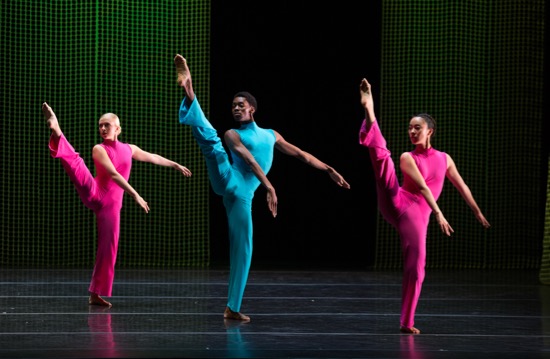
(L to R): Paige Borowski, My’Kal Stromile, and Hannah Park of Juilliard Dance’s Class of 2018 in Pam Tanowotz’s thunder rolling along afterward. Photo: Rosalie O’Connor
By their third year, Juilliard dancers should have a pretty good idea of what’s out there in the New York dance world and beyond. I doubt they went away from their first rehearsals for Pam Tanowitz’s thunder rolling along afterward, feeling endangered by its score: seven of the nine sections of Andrew Norman’s extraordinary 2010 string trio, The Companion Guide to Rome. I’m glad that George Meyer (violin), Hayaka Komatsu (viola), and Issei Herr (cello) sit on the stage left apron so we can see them create, say, the storm-of-flying-insects cloud of sound in the first section (“Teresa”), the almost inaudible whining of “Susanna,” or the extremely high, sweet violin melody that begins “Clemente.” What do you do to make a stringed instrument not just sing, but sound like a cat scratching at a door to gain entrance? Long silences may occur, and not just between selections.
Taylor’s set for thunder rolling along afterward consists of panels of green netting (roughly the texture of a badminton net). Those at the back frame several openings, and dancers work behind and between them. The front ones rise near the beginning of the dance and descend at the end. The twenty dancers wear sleeveless pantsuits—red or pink for the women, blue, green, or lavender for the men. At three performances, women dance the featured roles, and men taken them on in the remaining two shows. An additional challenge for the performers.
Tanowitz’s choreography frequently congeals into stillness, into poses. Circles and a central cluster of dancers make their first appearance of the evening. But the atmosphere is that of a situation that those in it either don’t understand, or of a strange jumpy lifestyle that we don’t understand. Whatever it is, it’s fascinating. The movement emphasizes linearity; the expert dancers hold their bodies in mostly straight, clean lines and keep their feet busy much of the time (Merce Cunningham could be an influence). They’re extremely energetic— springing about, taking big hops, leaping. Curious images snag your eyes. I remember partners holding hands in difficult situations—for instance, one of them still and preoccupied, while the other hops over and over, as controlled as a dog at the end of a leash. So if thunder is rolling along afterward, these may be the flashes that lightning shows us.
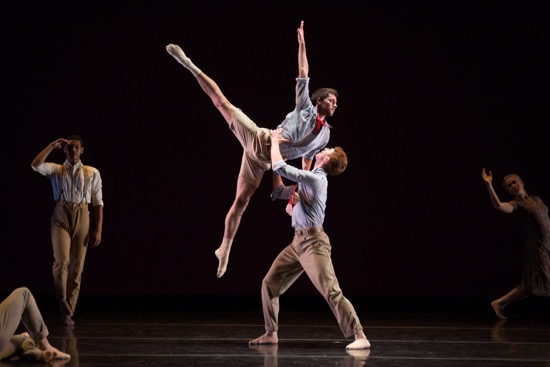
Matthew Neenan’s Walk Me Through for Juilliard Dance’s Class of 2017. (L to R): Malik Williams, Conner Bormann, Riley O’Flynn, Eliza Jones. Photo: Rosalie O’Connor
The twenty-two fourth-year students who populate Matthew Neenan’s Walk Me Through dance to recorded music: five mostly nostalgic songs by Rufus Wainwright. The dancers are outfitted in the kind of clothes they might have worn to an outdoor summer party a few decades ago: shorts or long pants, shirts, suspenders, here and there a pretty, lightweight dress. There’s quite a bit of unison in this, and some enigmatic recurring gestures, such as dancers framing their faces with their hands or cupping their chins, or perhaps (once) blowing s kiss, but Neenan also pinpoints individuals. He is adroit at tempering big movements with smaller, mor detailed ones. The occasion is not overtly celebratory. A duet for two men Conner Bormann and Riley O’Flynn begins in slow motion, gets faster, edges into violence, and subsides. People feed in and out of patterns. They slip into poses, exhibit differences, but easily join crowds on the move.
All four groups of students on display in Juilliard Dance perform with professional aplomb, so perhaps it’s partly my knowledge that this last-year group is getting close to its 2017 graduation that makes me see them as ready to set out on careers in the field of dance. Or put it this way: in a sense, they’ve already embarked.
